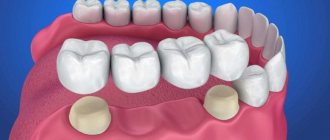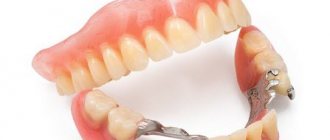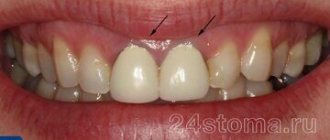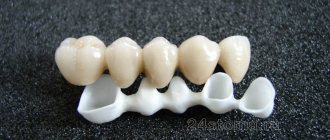Fixed prosthetics is a popular method of restoring the appearance and chewing-aesthetic function of the dentition. Reconstruction of damaged teeth with artificial prostheses covering only the supragingival part of the tooth is performed with metal, metal-ceramic, all-ceramic, metal-plastic and other crowns. Metal-ceramics are most in demand because... in terms of external data and technical characteristics, it is not much inferior to metal-free ceramics.
A metal-ceramic prosthesis consists of a frame based on a cobalt-chromium alloy, titanium, galvanic gold, platinum or palladium, coated on top with a ceramic mass. Based on the quality of ceramics, crowns are divided into standard and highly artistic.
Differences from metal and all-ceramic
A metal-ceramic (MC) crown is the best option for covering the destroyed coronal part of a tooth, because with its help, size, shape, color and chewing function are restored. However, the tooth must first be treated with endodontic methods.
All-ceramic products are distinguished by their artistry, less thickness because they lack a metal frame, but also greater fragility. In this regard, metal-free crowns are placed mainly on the frontal areas, although they are also allowed on premolars, because they don't have to bear a lot of stress when chewing. In addition to ceramics, porcelain crowns based on zirconium dioxide are used in their pure form. This is a white translucent metal that serves as a substrate for applying ceramic mass. The small thickness of the prosthesis allows the use of a minimally aggressive technique for preparing vital teeth.
Metal crowns are made by casting or stamping from gold, silver-palladium compounds, cobalt-chromium and nickel-chromium alloys. These thin-walled copings are designed to strengthen the coronal portion. Their appearance is unpretentious, so they cover only the chewing group of teeth. Prostheses made of base metals are available without sputtering (“silver-like”) and with sputtering (“gold-like”). Products made from electroplated gold are convenient in cases where the patient has a history of allergies to metals.
Operation
Medium difficulty
There are contraindications
Doctor's qualifications
High
Metal ceramics and zirconium, make your choice wisely
This article has already discussed the differences between ceramic-metal properties and ceramic-coated zirconium. If you are faced with a dilemma: zirconium dioxide and metal ceramics, then analyze everything and make the right choice.
If the front teeth require replacement, then it is better to use ceramics with a zirconium frame. For the chewing zone, you can use both metal-ceramics and zirconium oxide - it doesn’t matter. In both the first and second cases, reliability and durability are guaranteed, and aesthetics are not important here.
Metal-ceramic crowns - photo
The photo shows the following types of metal-ceramic crowns:
- For side sections;
- Frontal crown;
- On a frame made of irradiated gold;
- MK with pin;
- Telescopic;
- Half-crown.
Photo of dental crowns
How often do you visit the dentist?
Advantages of metal-ceramic crowns
There are many advantages of metal-ceramic dentures:
- The color, shape, size, transparency and strength of the artificial prosthesis are identical to the patient’s own teeth;
- Strengthening and reinforcing the crown part gives the tooth a “second” life for many years;
- Metal ceramics do not change color and soft and hard deposits do not accumulate on it;
- The degree of abrasion of ceramics is close to that of enamel;
- Due to the exact correspondence of the shape and size of the metal frame to the contours of the stump, the crowns “sit” firmly and do not allow microorganisms to pass under them;
- The metal base gives the crown increased strength, so “protected” teeth can withstand high mechanical loads;
Cost of the operation
from 20,000 rub.
Recovery time
from 3 days
Operation time
from 60 to 180 minutes
Features of working with the Vita scale
An experienced dentist who has been involved in dental prosthetics for a long time takes into account all the nuances that influence the selection of the color of future dentures. So, you have to take into account:
- lighting of the dental office;
- background for wall and furniture decoration;
- texture and color of the patient’s clothing;
- human skin tone.
The doctor’s perception is also important: for high-quality work, there should be no “clouding” of the eye, which happens when the examination takes too long.
Flaws
The disadvantages of metal-ceramics are mainly due to the thickness of the prosthesis. The metal frame and ceramic layer force the dentist to sharply grind the tooth. Therefore, dental units subject to prosthetics are first subjected to endodontic treatment. This is undesirable for a healthy tooth, since depulpation makes it more fragile.
Dental prosthetics with products is not recommended for children under 16 years of age due to the thin enamel-dentin layer and the close proximity of the horns of the pulp chamber, which means depulpation will inevitably be required.
The ceramic mass completely covers the metal base, with the exception of a small gap on the lingual side. The open metal part (“garland”) can cause discomfort in the oral cavity, and in cases where the patient already has other metal dentures, galvanization phenomena are possible.
In the frontal area, products made from MC may not look very natural, so here it is advisable to do prosthetics with all-ceramic crowns.
How to care for metal-ceramic teeth?
For long-term and comfortable use of metal-ceramic structures, proper oral care is necessary. The rules are standard: brush your teeth daily - in the morning and before bed.
To prevent chipping of ceramic veneers, it is recommended to grind down the high points on the surface of the crowns, as well as remove subgingival plaque and stone every six months.
When the veneer of a metal-ceramic tooth is chipped, the doctor carries out restoration using gel composites followed by polishing the surface.
Types of metal-ceramic crowns
The main task of a MC prosthesis is to protect and strengthen the heavily damaged crown part of the tooth. Such crowns completely envelop the tooth on all sides.
There are crowns with a pin that serve both to restore the integrity of the tooth and to strengthen it. They are used for very badly damaged coronal parts. The pin is cemented into one of the roots of the tooth.
A half-crown is a prosthesis covered with ceramic mass only on the oral and chewing sides (or on the cutting edge side), as well as on the sides in contact with neighboring teeth. The lingual side of the prosthesis remains uncovered. Typically, such measures are resorted to to reduce the cost of the crown.
Telescopic crowns have an internal built-in lock designed for fixation to the stump inlay on the abutment tooth of a removable denture.
Based on the manufacturing method, a distinction is made between MC prostheses that have undergone sintering or those made by computer modeling and milling.
Metal-ceramic color palette
Photo: color of metal-ceramics
Many people worry that metal-ceramic crowns will have a different shade than their natural teeth and it will look somewhat unaesthetic. But ceramics, which is used in dental prosthetics, makes it possible to imitate not only the color, but also the structure of natural enamel, which will make such a tooth extremely similar to its neighbors. The color palette of metal ceramics has its own Vita scale, under which it is selected. The color of such a prosthesis does not change over time and does not begin to fade, unlike the same natural enamel, as well as composite material (for example, fillings). Ceramic does not absorb dyes that may come from eating or drinking, so you will not need whitening services. When you feel that the metal ceramics located in the oral cavity need to be whitened, then you just need to go to an appointment with a hygienist who will remove plaque.
Indications for installation
Basically, metal-ceramic prostheses are placed in the following cases:
- destruction or traumatic fracture of at least 2/3 of the crown part of the front or chewing teeth;
- extensive fillings that spoil the aesthetics or do not adhere well to the teeth;
- anomalies in the shape, size, color or position of individual dental units that cannot be corrected by other dental methods;
- pathological abrasion of enamel;
- non-carious lesions of enamel, fluorosis;
- age-related changes in the shape, color, shine of individual teeth or disruption of their aesthetics after previous dental treatment;
- allergic reactions to crowns made of other materials;
- moderately loose teeth. In this case, prostheses are used for splinting, but they are not put on individual units, but in the form of a small metal-ceramic bridge;
- preparing an abutment tooth for attaching a clasp to attachments or a denture to telescopic crowns.
Crowns for all teeth
If two or more units in a row are missing in the dentition, then the prosthesis is made in the form of a bridge. It can be installed only if there are healthy teeth on both sides of the defect or at least intact roots that can act as a support.
Metal-ceramic crowns on all teeth are fixed as follows:
- the outer units are ground;
- if there is no coronal part, a pin is installed;
- The prosthesis is installed on the prepared supports.
During the production of permanent structures, it is possible to install temporary ones. As a rule, they are made of plastic and are low in cost.
Contraindications
Metal-ceramic crowns are not used for prosthetics in the following situations or conditions:
- destroyed crown part of the tooth in children under 16 years of age;
- low or flat coronal part with a thin layer of enamel-dentin layer and proximity to the pulp chamber;
- advanced periodontal disease;
- deep crossbite;
- parafunction of masticatory muscles and bruxism;
- pathological mobility of teeth 3 degrees;
- chronic periapical inflammation.
Stages of crown installation
Before starting to manufacture and fix the crown, the doctor conducts an examination and hardware diagnostics of the oral cavity, eliminates pockets of caries, and replaces old restorations on the problem tooth. Next, endodontic treatment is carried out. Only after this they begin to prepare and form a conical stump with a ledge. If the causative tooth fits into the smile line, it is covered with a provisional crown.
At the next stage, an impression of the teeth is taken, which is sent to the dental laboratory. Using it, the technician makes a working model from plaster and casts a metal frame (cap) that exactly follows the contours of the tooth stump. The cap is given to the dental clinic for fitting in the patient’s mouth. During the same visit, the color of the porcelain veneer is selected, and the cap is returned to the technician. He applies several layers of ceramic mass and fires the product in a kiln.
The almost finished MC crown is tried on the tooth. The doctor indicates the necessary changes on the accompanying sheet. The technician makes adjustments and begins glazing the denture to give it the shine and refractive structure of natural teeth. To make the dental prosthesis look like adjacent teeth, before glazing, the technician applies small spots or imitates cracks with a brush. This is especially true for crowns on front teeth.
At the last visit, the crown is tried on again, and if no errors were found, it is cemented.
Stages of manufacturing a metal-ceramic bridge prosthesis
The main indication for prosthetics using fixed bridges is the absence of one or more teeth.
Dental prosthetics using fixed metal-ceramic prostheses is one of the most common methods of treating violations of the integrity of the dentition and restoring chewing function. For this purpose, missing teeth are replaced with artificial ones, supported by adjacent teeth. The functional basis of such treatment is the reserve capacity of the dentition, which allows it to withstand additional load.
A fixed metal-ceramic bridge prosthesis is a structure consisting of one or more artificial (metal-ceramic) teeth rigidly attached to adjacent natural teeth using fixing elements - metal-ceramic crowns.
Typically, the number of supports in a bridge is two, but sometimes there is a need for three or more supports. Due to the fact that the supporting teeth experience pressure not only directly on them, but also on the intermediate part of the bridge, the number of replaced teeth cannot be too large. As a rule, this is 1-2 teeth.
The manufacturing process of a metal-ceramic bridge consists of clinical and laboratory stages.
Clinical stage
After the examination, if necessary, preliminary treatment is carried out: gum treatment, filling of supporting teeth and, if this is unavoidable, removal of the pulp and filling of root canals.
Then the teeth are prepared, on which the crowns that are part of the metal-ceramic bridge will be placed. This stage consists of grinding down their convex surfaces that prevent the crown from being put on.
After processing the teeth, an impression is taken and a plaster model of the missing dentition, along with data on the state of the bite, is sent to the dental laboratory.
Laboratory stage
In the laboratory, jaw models are made, on which the frame of the bridge is formed from wax, and then the metal frame is cast in a foundry.
Then the frame can be coated with a golden sublayer, which, due to the high gold content, allows the ceramic mass to be applied in an ultra-thin layer, through which the black or dark gray color of the oxide film covering the surface of the metal frame will not show through.
Next, the frame is covered with ceramic mass. The ceramic coating is applied in layers in accordance with the colors selected by the orthopedic surgeon. The “face bow” data is transferred to the articulator and the bridge is finally modeled in shape, taking into account the bite and relationship of the teeth during movement.
A bridge is a rather complex structure, so another intermediate visit is required - fitting of the frame. During the third visit, the final correction is made. The ceramics are covered with glaze, which gives the prosthesis a natural look, and with the help of special cement, the metal-ceramic prosthesis is fixed to the teeth.
Stages of manufacturing a metal-ceramic crown
The traditional manufacturing process of metal-ceramic crowns involves the following steps:
- Determination of tooth color, characteristic features, structure of enamel, dentin, determination of the transparent layer, the presence of individual characteristics (enamel cracks, staining of fissures in the chewing group of teeth, the presence of chalky stains, enamel abrasion, etc.).
- Next comes the removal of the destroyed dental tissue and the process of preparation (grinding) of the tooth, which takes a very long time. In order to ensure that after installing a metal-ceramic crown there is no effect of the so-called “blue” gum or compression of the gingival dental papilla by the crown, the doctor must very carefully grind the tooth to create a gingival ledge (the angle on which the crown will rest). Only with this method will the work be successful.
- An impression is then taken and sent to the laboratory.
During the production of permanent metal-ceramic structures, a temporary crown is placed, which hides the defect and eliminates psychological discomfort.
- After the metal frame is made, ceramic masses are applied to it layer by layer, recreating natural teeth as accurately as possible. Next comes the artistic design of the metal-ceramic crown, taking into account the individual characteristics of the tooth.
- Then follows the fitting of an almost finished metal-ceramic crown (a metal frame with ceramics already applied, but not glazed). At this stage, the color of the crown is finally determined, because You can still make changes.
Finally, at the last visit, the permanent crown is placed. The entire process of manufacturing a metal-ceramic crown takes on average up to 10 working days.
Materials used in metal ceramics
In metal-ceramics, a metal frame is used as a base, which solved the problems of excessive fragility of ceramics. Ceramic is applied layer by layer to the outer surface of the metal and held firmly in place by sintering. As a result, a metal-ceramic crown is reliable, durable and very beautiful. Plus, it looks like a real healthy tooth.
To effectively protect teeth from destruction under crowns, teeth are treated with a protective paste that releases fluoride into the tooth tissue. Modern dental cements are used to fix metal-ceramics, which makes it possible to achieve the strongest fixation. A high-quality metal-ceramic structure lasts for decades. The average service life of cermets on base alloys is 10-12 years. On gold-platinum alloy 15 years or more.
Ceramic lining in metal ceramics
The quality of a metal-ceramic prosthesis depends on many factors. Color accuracy is determined mainly by the quality of the ceramic mass. Imported ceramics convey color more accurately than domestic ones; in addition, they are more stable during processing and use - they do not change color when fired, and do not crack.
Applying porcelain mass to a metal frame is a long and painstaking job, since it is applied in layers and after each application the mass is fired in a special vacuum oven. Firing metal ceramics is a very important task. If the temperature or barometric modes are chosen incorrectly, the ceramics will crack and all the work will have to be done again. It is thanks to the layered application of porcelain that metal-ceramic teeth accurately convey the color and transparency of natural teeth. In addition, porcelain is intertwined with the tissues of the oral cavity and is hygienic.
Recently, ceramics have appeared in world dental practice, having a rigidity coefficient comparable to that of healthy teeth, which makes it possible not to injure or abrade antagonist teeth when chewing.
The use of the latest technologies allows you to give metal ceramics any color. Typically, the color of metal-ceramics is as close as possible to the color of the patient’s teeth. To do this, doctors use a set of small porcelain plates in the shape of a tooth (each plate has its own shade); Dentists call such sets a “color chart.” Depending on the specific situation, a metal-ceramic crown can be made so that porcelain covers only certain sides of it that are visible when smiling and talking, and the remaining parts of the crown are made completely metal.
The world leaders in the production of dental ceramics and porcelain are Ducera, Noritake.
One of the leading factors when choosing porcelain for ceramic cladding is the constancy of its coefficient of thermal expansion, which prevents the occurrence of cracks in the ceramic coating even during the manufacture of extended multi-unit structures. Some manufacturing companies produce porcelain, the coefficient of thermal expansion of which does not change during multiple firings, and is also little sensitive to the selected firing mode, therefore metal-ceramic products coated with such porcelain can be successfully fired in any dental furnace, starting from the simplest ones with a strictly specified heating rate , and ending with ultra-modern ones.
Another important criterion for choosing porcelain for metal-ceramic dentures is its strength. According to the international standard ISO 9693 “Dental metal-ceramics for dental prosthetics,” the flexural strength of porcelain must be at least 50 MPa.
Another pleasant distinguishing feature of some types of porcelain is their resistance to greening when applied to metal frames made of semi-precious silver-based alloys.
Metal-ceramic crowns - cost of installation
The cost of a metal-ceramic prosthesis includes the work of the doctor and technician, preparation of the tooth for prosthetics and the type of crown. So, if the crown frame is made of gold-containing alloys, then this will increase the total amount by one and a half times (approximately it costs 15-18 thousand rubles). If nickel-chromium or cobalt-chromium alloys are used as a frame, a single crown will cost from 6,500 rubles. Crowns for implants are more expensive, their price ranges from 18,000-20,000 rubles per unit. Highly artistic MKs for the front areas of the jaw will take about 11 thousand rubles from your budget.
Please note that tooth preparation before prosthetics (treatment of caries, pulp removal, replacement of old fillings) is paid separately.
Features of care and service life
The average service life of a crown made from MC is 10-15 years, and with proper individual oral care and regular visits to the dentist for professional hygiene, they can last up to 25 years.
Oral care after prosthetics is no different from what the patient is used to. Brushing your teeth twice a day, rinsing your mouth after eating, using additional hygiene products and devices - dental floss, rinses, brushes, irrigator.
To get a consultation
How long does cermet last?
Dental crowns made from metal ceramics are quite durable. On average, the service life of products is at least 10-12 years. But patients who choose this type of prosthetics need to know that the service life directly depends on several factors:
- correct preparation of teeth for prosthetics. If the canals are filled with poor quality, inflammatory processes soon occur, the gums become swollen, and the patient feels severe pain. As a result, the dentures have to be removed, the tooth must be treated, and the denture must be made in a new way;
- orthopedic professionalism. It is very important that the doctor performs the grinding of hard tissues flawlessly. If irregularities and tubercles remain on the tooth, then the prosthesis will not fit tightly to the tooth tissue. Food, saliva and air enter the resulting gaps and very soon carious processes occur in such cases;
- experience and technical skill. It determines how closely the prosthesis matches the shape and shade of natural teeth.
By seeking prosthetic services at the Beryozka clinic in Balashikha, you can be sure that all stages will be performed flawlessly and you will receive a guarantee on the installed crowns.











